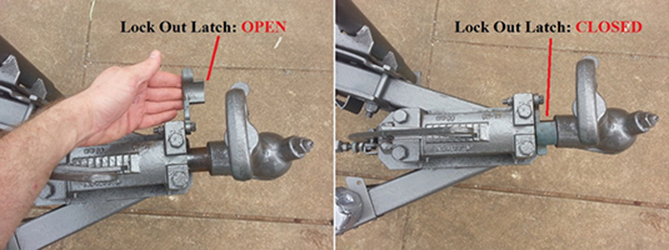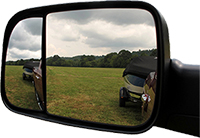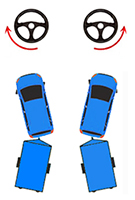For a lot of people, the thought of reversing a trailer into a tight space is very intimidating, often to the point where they will avoid it altogether. If this sounds like you then maybe its time to give it a go. With Abel’s helpful tips and a bit of practice you’ll be reversing like a pro in no time!
- Keep your cool
- Get a spotter
- Plan your route
- Check your trailer
- Set yourself up
- Use your mirrors
- Remember to watch the vehicle
- Steering your trailer
- Correct early, correct often
- If in doubt, get our
Keep your Cool
Regardless of the situation, the most important thing to remember is to stay calm. Ultimately you want to keep your movements slow, steady and relaxed. Even if you have a bit of a crowd or maybe some traffic waiting to get past, take your time and be cautious.
If you don’t feel comfortable with your current line, drive forward and try it again as many times as it takes. It is not worth damaging something for the sake of pride or to keep that impatient driver from a 30 second delay!
Get a Spotter
If possible, get a friend to help you out. One of the hardest things about reversing a trailer is trying to see what’s happening around both your car and trailer while trying to keep visual contact with possible hazards. With a second set of eyes helping you out you can focus on keeping your trailer under control and have a bit more confidence in what you’re doing.
If you do have some assistance, be sure to communicate with them frequently and make sure they stay visible in your mirrors at all times. A combination of voice and hand signals always works best so make sure they are clear, sharp instructions; confusing “go” and “no” can have disastrous consequences.
Plan Your Route
Before you even get in the car you should always do a quick check of where you plan to reverse. Even if you’re very familiar with the area, you need to be sure that your path is clear of all possible hazards. Check for any objects you need to be aware of like pot plants, taps or downpipes and be sure to include anything overhead.
One aspect often overlooked is the height of the trailer. Get a rough idea of the highest point of your vehicle and trailer and check for any hazards above. If you think it may even come close to hitting anything then its often best to get out the measuring tape. You might think to yourself that you’ll just take it easy when you get to that part but its something that can be easily forgotten.
If your trailer is going to come anywhere near a low-hanging power line, stop. It should always go without saying but never take any risks in this situation. Either adjust your load until you know its clear or carry the items by hand.
Check Your Trailer
Now that you know your route is clear, its time for a quick inspection of the trailer. You need to be aware of anything that may beprotruding from the back or sides of the trailer so you can either remove them or take them into account while reversing. You should also be checking for any possible hazards like a rope dragging on the ground.
Lockout Latch

(image courtsey of Adelaide Trailer Hire)
Larger trailers often use a braking system like the one pictured below. If this is the case and you are reversing uphill you may need to flip the lockout latch down (closed) to disable them temporarily, otherwise each time you try to reverse the trailer brakes will be applied! Just be sure to enable them again when you’re done.
Set Yourself Up
With everything else taken care of its time to get in the car and get started. To make life easier on yourself you should always start with your vehicle and trailer aligned with where you plan to go. The last thing you want is to be correcting the trailer right from the start.
This may mean that you need to drive another 5 – 10m forward but can save you plenty of time and frustration in the meantime.
Use Your Mirrors

When you do start reversing, remember to use your mirrors. Some people find it easier to turn around and look out the back window but this leaves a lot of dangerous blind spots and can make the process more difficult if you’ve never done it before. In some situations you may not be able to see out the back at all so learning to reverse with your mirrors is a skill well worth learning.
Your side mirrors can be used as a point of reference. If you’re reversing in a straight line then keep the trailer’s wheel arches even in both. If one is more visible than the other, your trailer is starting to turn that way and you need to correct it. The more visible it is, the harder your trailer is turning.
Keeping a constant eye on your mirrors also means you are more likely to spot any hazards early and gives you plenty of time to correct.
Remember to Watch the Vehicle!
Its easy to get caught up in everything that’s happening behind you but remember to look up frequently to make sure you’re not about to hit anything with the nose of your vehicle. You may only be making slight adjustments with the steering wheel but if you forget about it for long enough it may just be enough.
Steering Your Trailer

Something you may struggle with the first couple of times is steering in the right direction. It may sound simple but since the trailer will always turn the opposite way to your vehicle and you are already going in reverse, this situation doesn’t seem as intuitive as you might think
The easiest way to think about it is to look at the bottom of your steering wheel as the direction of the trailer. If you move the bottom of your wheel to the left, the trailer will go left.
Once you have this concept under control, remember to make small and frequent adjustments. Exactly how much you need to turn the wheel will vary widely depending on the length of the trailer so start with a quarter-turn and adjust accordingly.
Correct Early, Correct Often
Depending on the trailer, it may take a meter or two before it starts to respond to your steering movements. You need to allow for this and be patient or you will end up zig-zagging wildly from side to side down that straight driveway. Amusing as it may be, this is not the safest option.
Instead, anticipate your turns and begin steering in that direction once the back of the trailer reaches the turn point. If you’re steering around a corner then as soon as your trailer reaches it, begin to turn the steering wheel. By the time the wheels reach this point it should have started to come around.
Remember that the same concept also applies for straightening up. You need to begin straightening your trailer before the turn is complete or you will end up off-course and having to give it another go. Again, exactly how early you need to begin your turns will depend entirely on your trailer and getting a feel for it will come with practice.
If you are reversing in a straight line then be sure to make subtle movements often. If you see the trailer begin to move to one side, make a small correction straight away and it will be very easy to control.
If in Doubt, Get Out
With or without a spotter, if you are unsure of the situation or can’t confidently judge the clearance around your vehicle or trailer there is absolutely nothing wrong with getting out of the car and taking a closer look for yourself. If you find that you need to go forward and try it again to be safe then do it!
It is so common to see a driver getting frustrated with the situation and taking unnecessary risks. Does it really matter if backing your trailer takes 10 minutes? Remember, damage is expensive and potentially permanent. Take your time and stay safe.
Handy Hint: If you’re reversing at night you can use your brake lights to light up your surrounding and gauge your distance from hazards around you.
If you’re still not confident enough to reverse your own trailer or you’re unsure if its the best solution for you, perhaps you should hire a ute through Abel. At our excellent prices its always a great alternative!




